U.S. Department of Transportation
Federal Highway Administration
1200 New Jersey Avenue, SE
Washington, DC 20590
202-366-4000
The FHWA issued a new Interim Approval for the RRFB in March 2018. For more information, please consult:
Non-motorized users generally consist of cyclists and pedestrians but also include equestrian, horse-drawn buggies, in-line skaters, and other methods. Their needs must be addressed due to increased risks they encounter on rural roads. Rural pedestrian crashes are nearly twice as likely to result in a fatality and rural bicycle crashes are three times as likely to result in a fatality compared to urban crashes.27 Risky riding and walking behaviors may indicate that the transportation infrastructure does not adequately address the safety and mobility needs of non-motorized users.
| Safety Treatment | For more information, visit page | Cost | Frequency of Maintenance (years) | Safety Benefit | Benefit Cost Ratio28 | |||||
|---|---|---|---|---|---|---|---|---|---|---|
| Initial Implementation | Ongoing Maintenance | NCHRP 500 Performance Rating | Crash Modification Factor (CMF) | Lower Volume*, Optimal Conditions*** | Higher Volume**, Optimal Conditions*** | Lower Volume*, Narrower Conditions**** | Higher Volume**, Narrower Conditions**** | |||
| Provide Crosswalks at Targeted Locations | 73 | $ | P&T | |||||||
| Install Pedestrian Signal Heads to Existing Signalized Intersections | 74 | $$ | P | |||||||
| Construct Wildlife Fencing | 75 | $$ | T | |||||||
| Install Rectangular Rapid Flash Beacons (RRFBs) | 76 | $$ | P | |||||||
| Build Sidewalks | 77 | $$-$$$ | P | |||||||
| Construct Adjacent Shared-Use Paths | 78 | $$-$$$ | P | |||||||
| Construct Shared-Use Paved Shoulders for Horse & Buggy Road Users or Bicyclists | 79 | $$-$$$ | T | |||||||
| Construct Exclusive Bicycle Lanes | 80 | $$-$$$ | T | |||||||
| Install Curb Extensions | 81 | $$$ | T | |||||||
| Install or Modify Culverts to Accommodate Wildlife Crossing | 82 | $$$-$$$$ | T | |||||||
| Install Pedestrian Hybrid Beacons or High intensity Activated Crosswalks (HAWK) | 83 | $$$-$$$$ | P | 0.712 | ||||||
| Construct Bicycle Trail Grade Separation Structures | 84 | $$$$$ | P | |||||||
Cost: NCHRP 500 Performance rating29 *Lower Volume ≤ 1000 vpd |
||||||||||
Crosswalks help call attention to pedestrians crossing a road and provide a defined location in which to do so.
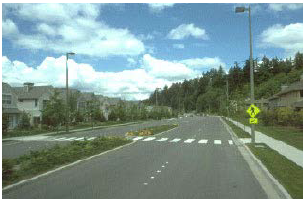
Where to use: Marked pedestrian crosswalks may be used to delineate preferred pedestrian paths across roadways under the following conditions:
Marked crosswalks alone (i.e., without traffic-calming treatments, traffic signals and pedestrian signals when warranted, or other substantial crossing improvement) are insufficient and should not be used under the following conditions:
| Safety Treatment | Initial Implementation Cost | NCHRP 500 Performance Rating |
|---|---|---|
| Provide Crosswalks at Targeted Locations | $0 to $5,000 | Proven and Tried |
Top Recommended Resource:
1. FHWA, Safety Effects of Marked Versus Unmarked Crosswalks at Uncontrolled Locations: Final Report and Recommended Guidelines, September 2005. Available at: https://www.fhwa.dot.gov/publications/research/safety/04100/04.cfm.
Pedestrian signal heads provide special types of traffic signal indications exclusively intended for controlling pedestrian traffic. These signal indications consist of the illuminated symbols of a walking person (symbolizing Walk) and an upraised hand (symbolizing Don't Walk).
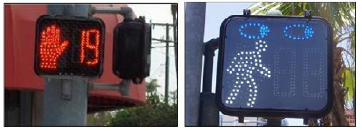
Where to Use: This treatment is applicable where pedestrian traffic exists at signalized intersections.
| Safety Treatment | Initial Implementation Cost | NCHRP 500 Performance Rating |
|---|---|---|
| Install Pedestrian Signal Heads to Existing Signalized Intersections | $5,001 to $20,000 | Proven |
Top Recommended Resources:
1. FHWA, Manual on Uniform Traffic Control Devices, "Chapter 4E. Pedestrian Control Features," December 2009. Available at: http://mutcd.fhwa.dot.gov/pdfs/2009r1r2/mutcd2009r1r2edition.pdf.
2. FHWA, Signalized Intersections Informational Guide, July 2013. Available at: http://safety.fhwa.dot.gov/intersection/conventional/signalized/fhwasa13027/index.cfm.
Wildlife fences help to prevent livestock and wildlife from straying onto highways.
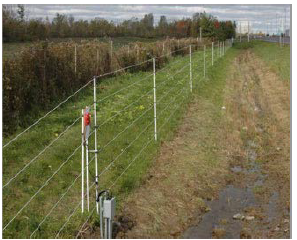
Where to Use: Wildlife fence may be constructed along the right-of-way at locations with expansive open plains, paths that are known to be a crossing area, or locations that experience a moderately high frequency of crashes involving wildlife. Several States give guidance on how and where to properly construct wildlife fencing.
| Safety Treatment | Initial Implementation Cost | NCHRP 500 Performance Rating |
|---|---|---|
| Construct Wildlife Fencing | $5,001 to $20,000 | Tried |
Rectangular Rapid Flash Beacons (RRFBs) are user-actuated amber Light Emitting Diodes (LEDs) that supplement warning signs at unsignalized intersections or mid-block crosswalks. They can be activated by pedestrians manually by a push button or passively by a pedestrian detection system. RRFBs can enhance safety by reducing crashes between vehicles and pedestrians at unsignalized intersections and mid-block pedestrian crossings by increasing driver awareness of potential pedestrian conflicts. RRFBs are also referred to as LED Rapid-Flash System, Stutter Flash or LED Beacons.
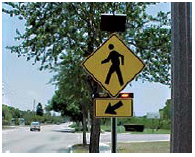
Where to use: RRFBs may be installed on either two-lane or multi-lane roadways at unsignlized intersections and mid-block pedestrian crossings.
| Safety Treatment | Initial Implementation Cost | NCHRP 500 Performance Rating |
|---|---|---|
| Install Rectangular Rapid Flash Beacons | $5,001 to $20,000 | Tried |
Top Recommended Resource:
1. FHWA, "Rectangular Rapid Flash Beacons (RRFB)," May 2009. Available at: http://safety.fhwa.dot.gov/intersection/resources/techsum/fhwasa09009/fhwasa09009.pdf.
Providing sidewalks and associated accommodations for pedestrians along heavily traveled corridors gives refuge for pedestrians and helps to enhance roadway operations, mobility, and safety. This treatment is especially useful at locations with heavy pedestrian volumes, such as business districts, schools, and community centers.
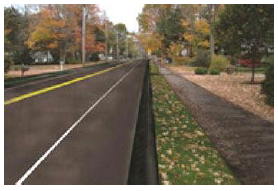
Where to Use: This treatment should be considered when heavy pedestrian volumes exist along a corridor or specific location, impacting the safety of all road users.
| Safety Treatment | Initial Implementation Cost | NCHRP 500 Performance Rating |
|---|---|---|
| Build Sidewalks | $5,001 to $50,000 | Tried |
A shared-use path serves as part of a transportation circulation system and supports multiple recreation opportunities, such as walking, bicycling, and in-line skating. A shared-use path typically has a surface that is asphalt, concrete, or firmly packed crushed aggregate. The 2012 AASHTO Guide for the Development of Bicycle Facilities defines a shared-use path as being physically separated from motor vehicular traffic with an open space or barrier. Shared-use paths should always be designed to include pedestrians even if the primary anticipated users are bicyclists.
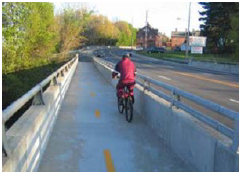
Where to Use: This treatment can be used when a high volume of non-motorized traffic exists along a corridor, such as along designated hiking trails or known bicycle routes.
| Safety Treatment | Initial Implementation Cost | NCHRP 500 Performance Rating |
|---|---|---|
| Construct Adjacent Shared-Use Paths | $5,001 to $50,000 | Tried |
Top Recommended Resources:
1. FHWA, Designing Sidewalks and Trails for Access, Part I of II: Review of Existing Guidelines and Practices, July 1999. Available at: https://www.fhwa.dot.gov/environment/bicycle_pedestrian/publications/sidewalks/.
2. FHWA, Designing Sidewalks and Trails for Access, Part II of II: Best Practices Design Guide, September 2001. Available at: https://www.fhwa.dot.gov/environment/bicycle_pedestrian/publications/sidewalk2/pdf.cfm.
3. AASHTO, Guide for the Development of Bicycle Facilities, 4th Edition, June 2012.
HRRR located near communities where horse and buggies are used in conjunction with motorized transportation may experience abrupt disruptions in traffic flow as faster moving vehicles overtake slower traffic; the same is true for HRRR that are known bicycle routes. Providing a paved shoulder adjacent to the travel way with sufficient width to accommodate alternate modes of transportation can help separate slower moving traffic from the travel lane.
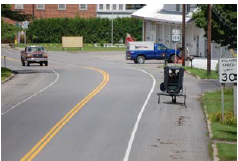
Where to Use: This treatment may be used at locations where slower moving traffic is known to exist frequently, such as bicycle routes and locations with horse and buggy users, and that experience a high frequency of crashes associated with the alternate modes of traffic coming in contact with motorized traffic.
| Safety Treatment | Initial Implementation Cost | NCHRP 500 Performance Rating |
|---|---|---|
| Construct Shared-Use Paved Shoulders for Horse & Buggy Road Users or Bicyclists | $5,001 to $50,000 | Tried |
Top Recommended Resources:
1. FHWA, Non-Motorized User Safety: A Manual for Local Rural Road Owners, November 2012. Available at: http://safety.fhwa.dot.gov/local_rural/training/fhwasa010413/nonmotorize.pdf.
2. AASHTO, Guide for the Development of Bicycle Facilities, 4th Edition, June 2012.
Bike lanes are defined as a portion of the roadway that has been designated by striping, signing, and pavement marking for the preferential or exclusive use by bicyclists. Bicycle lanes make the movements of both motorists and bicyclists more predictable and, as with other bicycle facilities, there are advantages to all road users in striping them on the roadway.
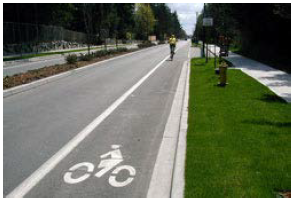
Where to Use: This treatment can be used when a high volume of bicycle traffic exists along a corridor, such as known State- or nation-wide bicycle routes.
| Safety Treatment | Initial Implementation Cost | NCHRP 500 Performance Rating |
|---|---|---|
| Construct Exclusive Bicycle Lanes | $5,001 to $50,000 | Tried |
Top Recommended Resources:
1. FHWA, Pedestrian and Bicycle Information Center, "Bike Lanes." Available at: http://www.bicyclinginfo.org/engineering/facilities-bikelanes.cfm.
2. FHWA, Bicycle Facilities and the Manual on Uniform Traffic Control Devices, February 28, 2014. Available at: https://www.fhwa.dot.gov/environment/bicycle_pedestrian/guidance/design_guidance/mutcd_bike.cfm.
Curb extensions extend the sidewalk or curb line out into the parking lane, which reduces the effective street width. Curb extensions significantly improve pedestrian crossings by reducing the pedestrian crossing distance, improving the ability of pedestrians and motorists to see each other, and reducing the time that pedestrians are in the street.
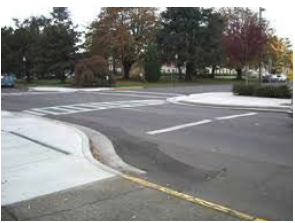
Where to Use: Curb extensions should typically be used where there is a parking lane and where transit and cyclists will be traveling outside the curb edge for the length of the street.
| Safety Treatment | Initial Implementation Cost | NCHRP 500 Performance Rating |
|---|---|---|
| Install Curb Extensions | $20,001 to $50,000 | Tried |
A mix of underpasses, bridge extensions, culvert installations, and culvert modifications can be used to facilitate wildlife movement and reduce collisions on HRRR associated with wildlife.
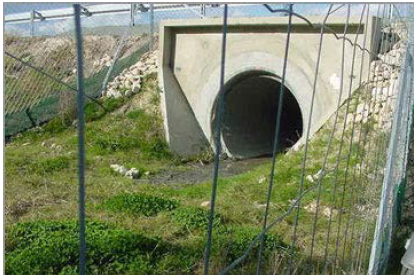
Where to Use: Culverts may be used to accommodate wildlife crossings at locations with expansive open plains, paths that are known to be a crossing area, or locations that experience a moderately high frequency of crashes involving wildlife. Several States provide guidance on how and where to properly construct wildlife fencing.
| Safety Treatment | Initial Implementation Cost | NCHRP 500 Performance Rating |
|---|---|---|
| Install or Modify Culverts to Accommodate Wildlife Crossing | $20,001 to $100,000 | Tried |
The HAWK is a pedestrian activated beacon located on the roadside and on mast arms over major approaches to an intersection. The HAWK signal head consists of two red lenses over a single yellow lens. It displays a red indication to drivers when activated, which creates a gap for pedestrians to cross a major roadway. The HAWK is not illuminated until it is activated by a pedestrian, triggering the warning flashing yellow lens on the major street. After a set amount of time, the indication changes to a solid yellow light to inform drivers to prepare to stop. The beacon then displays a dual solid red light to drivers on the major street and a walking person symbol to pedestrians. At the conclusion of the walk phase, the beacon displays an alternating flashing red light to drivers, and pedestrians are shown an upraised hand symbol with a countdown display informing them of the time left to cross.
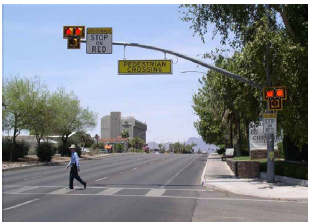
Where to use: This treatment may be used at locations with a high number of pedestrian crashes where additional visibility of pedestrian crossings is needed.
| Safety Treatment | Initial Implementation Cost | NCHRP 500 Performance Rating | Crash Modification Factor (CMF) |
|---|---|---|---|
| Install Pedestrian Hybrid Beacons or High Intensity Activated Crosswalk (HAWK) | $20,001 to $100,000 | Proven | 0.712 |
Top Recommended Resource:
1. FHWA, Safety Effectiveness of the HAWK Pedestrian Crossing Treatment, July 2010. Available at: https://www.fhwa.dot.gov/publications/research/safety/10042/.
This treatment can be an elevated or subterranean structure that minimizes or eliminates conflicts with motorized vehicles. Bicycle trail grade-separated structures allow for passage over otherwise un-navigable or difficultly-traversed locations such as waterways, rail, limited access freeways, or highvolume intersections.
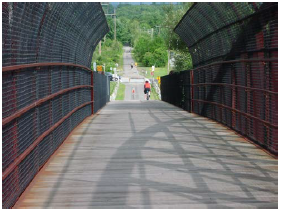
Where to Use: This treatment can be used at locations where safe passage of bicycles is difficult due to terrain, traffic volume, or geographic obstacles.
| Safety Treatment | Initial Implementation Cost | NCHRP 500 Performance Rating |
|---|---|---|
| Construct Bicycle Trail Grade Separation Structures | $100,001 and up | Proven |
27 UNC Highway Safety Research Center, Factors Contributing to Pedestrian and Bicycle Crashes on Rural Highways – Final Report, http://www.hsisinfo.org/pdf/HSIS-Rural-PedBike-Final-Report.pdf. [ Return to note 27. ]
28 As discussed in Section 1.2, a BCR is only shown where data were available to calculate the ratio. Where data were unavailable, the BCR has been left blank. [ Return to note 28. ]
29 As stated in NCHRP Series 500 Reports (http://safety.transportation.org/guides.aspx). Proven: The safety effect for other similar applications has shown a proven benefit. Tried: The treatment has indications that it can be expected to reduce crashes, but has some conflicting reports as to its associated safety effects or has been deployed and observed to be effective. Experimental: New treatments that still need to be tested and for which the safety effect is unknown. Unknown: Not enough is known about an associated safety performance. [ Return to note 29. ]
